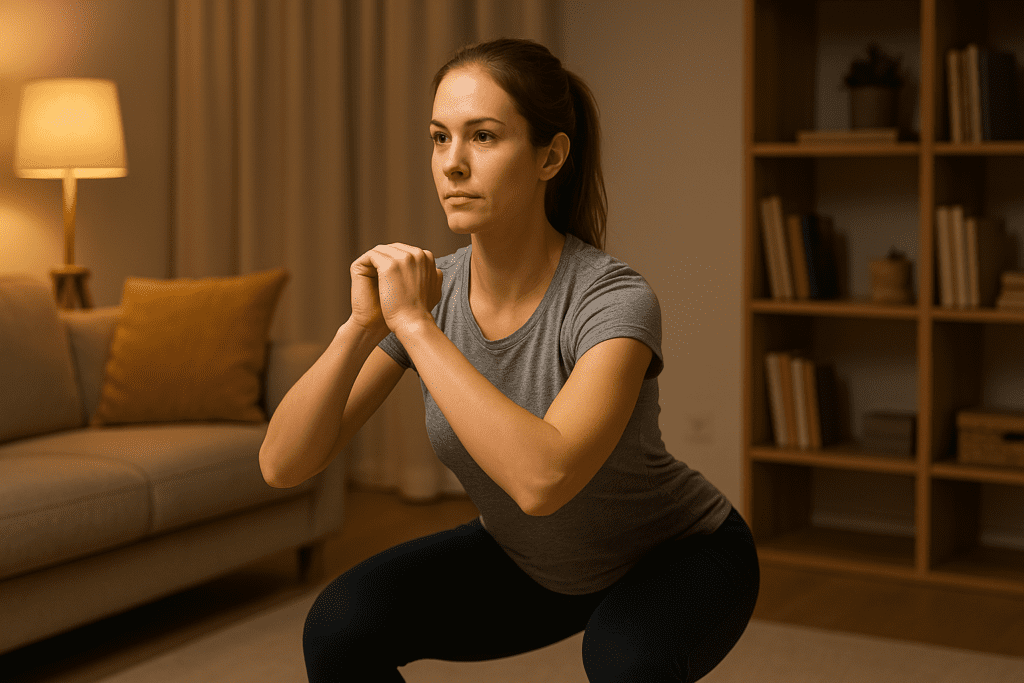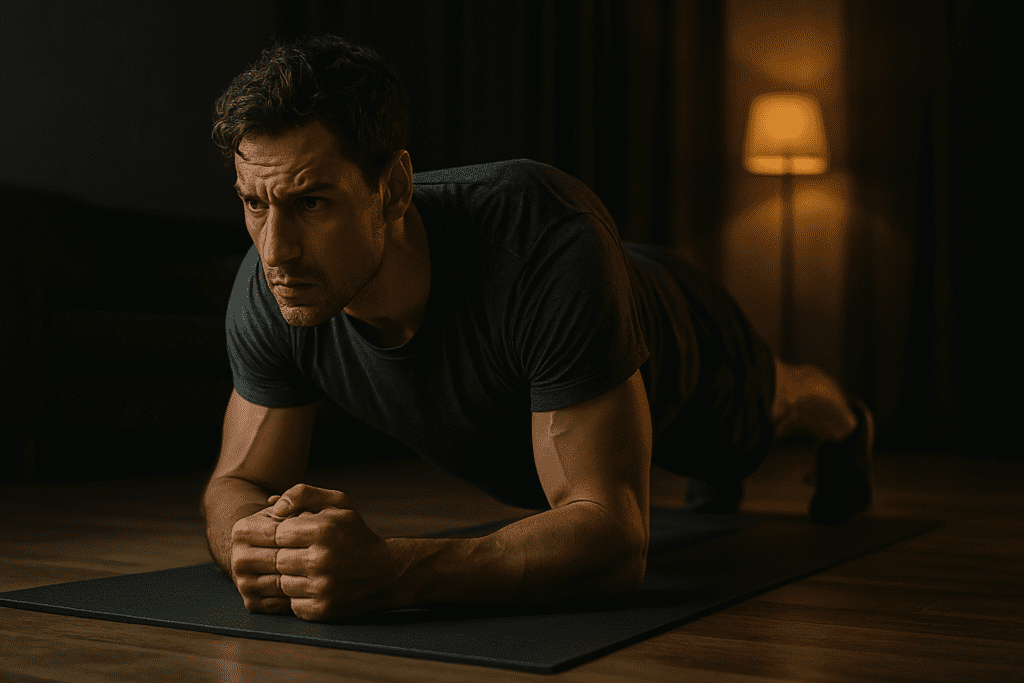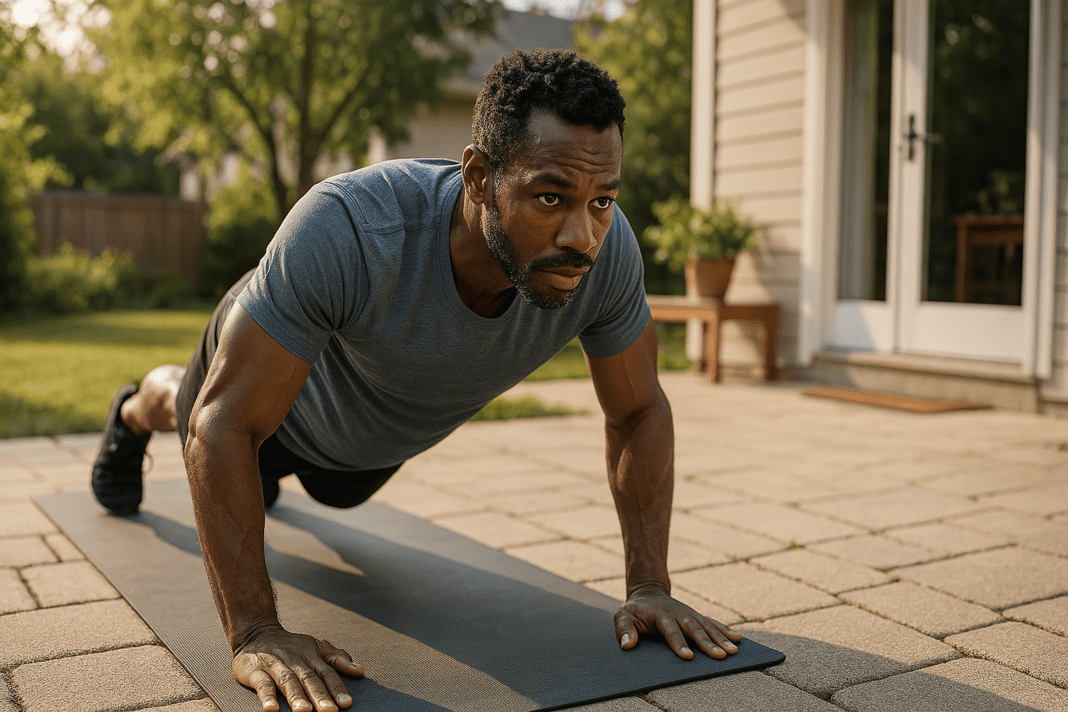Reclaiming Heart Health at Home: Why a Full Body Workout Without Equipment Matters
In a world that increasingly values convenience and flexibility, the idea of maintaining peak cardiovascular health through a full body workout at home without equipment has gained substantial traction. With sedentary lifestyles on the rise and time becoming a luxury, people are turning to smarter, simpler ways to prioritize heart health. Fortunately, the best at home workout doesn’t require a gym membership, expensive machines, or even a single dumbbell. It simply requires commitment, structure, and the willingness to move your body using what you already have—your own weight.
You may also like: Top Cardiologist-Approved Cardio Workouts to Improve Cardiovascular Fitness and Heart Health Naturally
Medical experts have long emphasized the role of consistent aerobic and resistance training in reducing cardiovascular risk factors such as high blood pressure, high cholesterol, obesity, and insulin resistance. Yet, many individuals still wonder, “How can I workout at home without tools?” or “Are easy home workouts really effective for the heart?” The answer is a resounding yes—when done properly, a home fitness plan with no equipment can be just as effective, and in some cases more sustainable, than gym-based routines. This article explores how to design and follow a doctor-recommended at home workout plan that supports whole-body fitness and cardiovascular strength, all from the comfort of your living space.
Understanding the Cardiovascular Benefits of Full Body Exercises at Home
Cardiovascular health doesn’t begin and end with a treadmill. In fact, aerobic and anaerobic exercises that elevate the heart rate and engage major muscle groups can be performed at home without any tools. Full body exercises at home not only improve heart function but also enhance circulation, lower resting heart rate, and boost oxygen delivery to tissues.
Many people underestimate the cardiovascular challenge that bodyweight exercises can present. Movements such as jumping jacks, burpees, mountain climbers, and even squats create a metabolic demand that prompts the heart and lungs to work harder, improving endurance and cardiac efficiency over time. Moreover, when these movements are strung together in circuit format with minimal rest, they replicate the intensity of a traditional cardio session, making them a great at home workout alternative for people aiming to support heart health.
What makes a full body workout at home particularly effective is its compound nature. Unlike isolated strength training exercises, compound movements involve multiple joints and muscle groups, leading to greater cardiovascular output. By integrating both upper and lower body engagement, exercises for whole body without equipment offer a holistic and functional approach to cardiovascular training that’s accessible to anyone, anywhere.
Building an Effective At Home Workout Plan Without Equipment
Designing a structured, sustainable at home workout plan without equipment requires a blend of cardiovascular and muscular training principles. While it’s tempting to follow random online routines, it’s far more beneficial to adopt a doctor-recommended strategy that gradually increases intensity and incorporates rest for recovery. For individuals new to fitness or returning after a break, beginning with workout routines for beginners at home is critical to establish a safe and consistent foundation.
A typical at home workout plan should include three to five sessions per week, lasting between 20 to 45 minutes each. Start with a dynamic warm-up to prepare the cardiovascular and musculoskeletal systems, followed by intervals of bodyweight movements that alternate between strength and cardio-based efforts. Finish with a cool-down and static stretching to improve flexibility and aid in recovery.
One of the best home fitness workout approaches is circuit training, where exercises are performed one after another with limited rest. For example, a circuit may include bodyweight squats, push-ups, high knees, lunges, and plank holds. Each movement can be performed for 30–60 seconds, with short rest periods in between. These easy workouts create metabolic stress and cardiovascular stimulus without the need for treadmills or resistance bands.
As endurance builds, users can adjust the workout routine at home by increasing repetitions, extending intervals, or reducing rest time. The key is to maintain variety, challenge different muscle groups, and prioritize heart-pumping movements.

Why a Workout Routine at Home Supports Long-Term Heart Health
One of the most overlooked advantages of working out from home without equipment is consistency. Gym access may fluctuate due to scheduling, travel, cost, or even public health concerns. But the ability to engage in good at home workouts—regardless of time, weather, or location—removes common barriers to exercise, making heart-healthy habits more sustainable.
Consistency is a cornerstone of cardiovascular wellness. Studies have shown that individuals who exercise regularly are significantly less likely to suffer from heart attacks, strokes, or hypertension. This is true regardless of whether the exercise occurs in a gym or living room. Full body workout at home routines that are maintained over time deliver similar heart rate improvements and blood pressure reductions as equipment-based regimens, provided they are performed with adequate intensity and regularity.
A home exercise routine also allows for immediate adaptation based on how your body feels. Unlike gym-based workouts, which may require long commutes or waiting for machines, a home fitness plan with no equipment is flexible and self-directed. This adaptability ensures you stay engaged, lowering the likelihood of missed sessions and increasing your chances of long-term cardiovascular success.
The Science Behind Workout Exercises at Home and Heart Function
Scientific evidence strongly supports the benefits of bodyweight training for improving cardiac output, vascular elasticity, and oxygen efficiency. Workout exercises at home that focus on high-repetition, low-rest movements stimulate both the aerobic and anaerobic systems. This dual activation not only strengthens the heart muscle but also enhances its ability to respond to stress.
Full body movements such as squat thrusts, bear crawls, and jumping jacks increase systemic blood flow, activating large muscle groups in the legs, core, chest, and arms. These compound actions boost heart rate and circulation in a way that mimics traditional cardio, but without requiring a single piece of equipment. Furthermore, exercises at home often demand greater core stabilization and joint control, which promotes muscular balance and functional strength—both of which are critical for overall cardiovascular efficiency.
Another benefit lies in the hormonal response to these workouts. Intense yet brief circuits trigger the release of endorphins and nitric oxide, which help dilate blood vessels and reduce blood pressure. The result is not just better fitness but an internal environment that supports heart healing and resilience.
Creating the Best Home Fitness Workout Without Tools
When choosing the best home fitness workout, it’s important to focus on variety and progression. A program that challenges the heart while avoiding overuse injuries is one that evolves with your capabilities. Rotating between cardio-focused and strength-based routines can help prevent boredom and stagnation, making it easier to stay motivated over time.
To structure a balanced week of fitness at home, alternate between easy home workouts that prioritize recovery and high-intensity circuits that challenge cardiovascular endurance. For example, one day may involve steady-state movement like marching in place and yoga-inspired flows, while another features explosive combinations like skater hops and jump squats.
Even without gym tools, progression is possible by manipulating workout variables such as speed, duration, and rest intervals. Tracking your performance and gradually pushing the threshold is the foundation of any effective home fitness plan no equipment. Those seeking an extra layer of personalization can also consult a certified exercise physiologist or physical therapist for tailored modifications that account for age, fitness level, or cardiac history.
Working Out from Home Without Equipment: Tips for Safe and Effective Training
Engaging in a full body workout at home without equipment doesn’t mean compromising on safety or form. In fact, working out from home without equipment often encourages greater mindfulness in movement. Without machines to guide your range of motion, you become more attuned to your body mechanics and posture.
To minimize injury risk, start each session with a five-minute warm-up consisting of movements like arm circles, hip rolls, and light jogging in place. These gentle actions prepare your joints and heart for more demanding tasks. During the workout, focus on quality over quantity. It’s better to complete fewer repetitions with correct form than to rush through sloppy movements that can strain the knees, back, or shoulders.
Hydration and breathing are equally important. Take water breaks as needed and prioritize deep, diaphragmatic breaths to oxygenate your muscles and regulate heart rate. If you’re unsure whether your at home exercise routine is challenging enough, monitor your rate of perceived exertion or use a heart rate monitor to stay within your target training zone. Always cool down with stretches for the hamstrings, quadriceps, chest, and lower back to prevent stiffness and support circulation.
Home Exercise Without Any Equipment: Debunking Common Myths
There’s a persistent belief that home exercise without any equipment is somehow inferior to gym-based training. However, this couldn’t be further from the truth. The body itself is a highly adaptable and powerful resistance tool, capable of building strength, endurance, and cardiovascular function through simple yet effective movement patterns.
One common myth is that without weights, you can’t build muscle or protect the heart. In reality, exercises like push-ups, wall sits, and planks activate large muscle groups while providing sufficient resistance for both strength and endurance gains. These movements also challenge stabilizing muscles and increase proprioception, which contributes to overall coordination and fall prevention in older adults.
Another misconception is that workout no equipment routines lack progression. Yet, by introducing new movement combinations, changing your tempo, or adjusting your exercise order, you can continuously evolve your program. This adaptability makes a workout without tools especially ideal for individuals managing cardiovascular disorders, as it allows for controlled intensification based on medical guidance and comfort level.
Good At Home Workouts for Cardiovascular Rehabilitation and Prevention
For individuals recovering from cardiovascular procedures or managing chronic conditions like hypertension, diabetes, or dyslipidemia, good at home workouts offer a non-intimidating entry point into physical activity. Cardiac rehabilitation programs often begin with low-impact bodyweight movements that can be transitioned seamlessly into an at home setting.
These routines prioritize slow, controlled motions and gradual increases in workload. Examples include step-ups on stairs, seated leg lifts, and walking lunges. The beauty of easy home fitness plans lies in their adaptability. They can be modified for mobility limitations, energy levels, or physician restrictions without sacrificing cardiovascular benefit.
Furthermore, structured exercise at home plays a crucial role in the prevention of future cardiac events. Regular movement improves lipid profiles, regulates glucose metabolism, and reduces systemic inflammation—three of the most significant predictors of cardiovascular disease. When embedded into a consistent lifestyle routine, an at home workout becomes not just a fitness goal but a powerful tool for lifelong heart health.
Exercise Without Any Equipment: Empowering Women and Underserved Populations
Accessibility remains one of the most powerful advantages of exercise without any equipment. For many women, particularly those balancing caregiving, career, and personal health, finding time for structured gym visits can feel nearly impossible. A well-designed exercise routine for women at home provides autonomy, flexibility, and privacy while delivering the cardiovascular benefits necessary for long-term wellness.
This approach is also critical in reaching underserved communities where access to fitness centers or professional trainers is limited. Free and low-cost resources now allow people to discover full body exercises at home through virtual platforms and public health campaigns. These resources eliminate the socioeconomic barriers that often prevent engagement in physical activity.
In addition, the inclusivity of these workouts—regardless of fitness level, body size, or medical history—makes them ideal for population-wide cardiovascular risk reduction. With thoughtful design and medical guidance, an at home workout plan can become a cornerstone of community health, reaching beyond individuals to impact families and neighborhoods alike.

Easy Workouts That Deliver Real Results: How to Stay Motivated at Home
One of the most challenging aspects of maintaining a consistent workout routine at home is motivation. Without the structure of a gym schedule or the accountability of group classes, even the best training at home can falter over time. To counteract this, behavioral psychology suggests incorporating habit-stacking techniques, visual cues, and rewards into your at home exercise routine.
Start by linking your workout to an existing habit, such as doing a 10-minute morning warm-up after brushing your teeth. Keep your workout clothes or mat visible in your living space to create a subtle prompt. Track your progress using journals, apps, or fitness logs and celebrate small milestones—whether it’s increasing your plank time or completing your first full circuit without rest.
Another strategy is to rotate your workout routines for beginners at home every two to three weeks. This prevents mental burnout and ensures your body continues to adapt to new challenges. Listening to music, following guided online videos, or partnering with a friend for virtual workouts can also enhance engagement. The goal is to make each session feel like a personal investment rather than a chore.
Frequently Asked Questions: Full Body Workout at Home Without Equipment – Expert Insights for Sustainable Fitness and Heart Health
1. How can I ensure progress with a full body workout at home without using equipment?
Progress in a full body workout at home is all about intelligent adaptation rather than the use of external weights. One powerful method is increasing time under tension—by slowing down each rep, you force your muscles to work harder. Another effective tactic is manipulating your rest intervals between sets to challenge cardiovascular recovery, a technique widely used in professional athletic training. You can also layer difficulty into your at home workout by combining movements—for example, adding a jump to a squat or incorporating a push-up into a plank walk. These compound movements evolve basic exercises at home into a highly efficient and dynamic cardiovascular challenge that supports both muscular growth and heart health. Over time, what begins as a good at home workout can become a powerful tool for endurance and performance with zero reliance on gym tools.
2. What are the psychological benefits of following an at home workout plan consistently?
While physical improvements are the most obvious result of a full body workout at home, the mental benefits are equally profound. Exercise promotes neurogenesis—the creation of new brain cells—which enhances memory, concentration, and emotional regulation. Following a structured at home workout plan can help stabilize circadian rhythms, reduce symptoms of anxiety, and create a sense of control in daily life. The simple act of maintaining a workout routine at home reinforces personal discipline and self-efficacy, traits that are foundational to long-term behavior change. For many people, this shift in mindset becomes a springboard to greater emotional well-being, better sleep, and enhanced resilience under stress.
3. Are there advanced strategies for making exercises for whole body without equipment more effective?
Absolutely. Advanced bodyweight training relies on techniques such as unilateral movement, which increases the load on each side of the body, enhancing muscular recruitment and cardiovascular effort. For example, transitioning from standard squats to pistol squats or from push-ups to archer push-ups significantly increases the difficulty. Isometric holds, like a prolonged plank or wall sit, also generate intensity without needing tools. Another proven method is integrating mobility into your workout exercises at home—dynamic stretches like inchworms or deep lunges with rotation improve joint function while keeping your heart rate elevated. By incorporating these variations into your at home workout plan without equipment, you elevate the challenge and effectiveness, ensuring continued growth and cardiovascular benefit.
4. How does working out from home without equipment impact long-term fitness adherence?
Working out from home without equipment removes several barriers that often derail consistency, such as commute time, gym fees, and schedule conflicts. This increased accessibility fosters a habit-based approach, which behavioral scientists agree is key to long-term adherence. Furthermore, home fitness promotes autonomy—you choose your time, pace, and setting—which boosts intrinsic motivation and emotional investment in the process. Many people find that having an at home exercise routine makes fitness feel less like an obligation and more like a natural part of daily life. With easy workouts available at your fingertips and minimal time commitment, the chances of staying consistent increase substantially, particularly when the program aligns with your personal goals and lifestyle.
5. What are the cardiovascular risks of poor form during full body exercises at home?
Form matters deeply, even when performing home exercise without any equipment. Poor posture during movements like squats or lunges can place excess strain on the knees and lower back, while misalignment during planks or push-ups can compromise the spine and reduce respiratory efficiency. When form is compromised, the cardiovascular system may work harder to compensate for the mechanical inefficiencies, leading to increased fatigue and reduced endurance benefits. This is especially important for individuals with existing cardiovascular disorders, as unstable movements could provoke spikes in blood pressure or heart rate. A thoughtful home fitness plan with no equipment should emphasize proper mechanics first, gradually layering in speed and intensity as skill improves.
6. How can I make a full body workout at home more engaging if I get bored easily?
One of the best strategies for maintaining engagement is rotating workout routines for beginners at home with themed or time-based formats. For instance, “EMOM” (Every Minute on the Minute) or “AMRAP” (As Many Rounds As Possible) formats turn your session into a mental challenge, not just a physical one. You can also explore cultural fitness variations—such as capoeira-inspired moves or dance-based cardio—to introduce novelty and rhythm. Audio-guided workouts, virtual fitness communities, and real-time heart rate tracking can also inject fun and accountability into your fitness at home. When your workout no equipment routine includes play, personalization, and progression, boredom rarely stands a chance.
7. What makes an at home workout plan without equipment ideal for women managing chronic conditions?
Women dealing with chronic illnesses such as PCOS, hypertension, or osteoarthritis often require low-impact, adaptable routines. An at home workout plan without equipment offers a controlled environment where women can modify intensity based on how they feel that day, without fear of judgment or overstimulation. Unlike traditional gyms, working out from home without equipment enables seamless integration of rest and recovery strategies between sets, which is crucial for managing fatigue. Many exercises for the whole body without equipment—like chair squats, bird dogs, or side-lying leg lifts—can be performed in cycles to support hormonal balance, cardiovascular strength, and joint health. For women seeking consistency and safety, an at home exercise routine provides both flexibility and medical alignment.
8. Can I achieve the same heart benefits with an at home workout as I would from running or cycling?
Yes, when structured properly, an at home workout can absolutely deliver comparable cardiovascular benefits. High-intensity bodyweight circuits—particularly those involving dynamic full body exercises at home—mimic the interval training commonly found in cycling or running regimens. Movements like high knees, mountain climbers, or fast-paced burpees stimulate aerobic and anaerobic systems, improving VO2 max and resting heart rate. Moreover, the flexibility to vary intensity and target multiple muscle groups in quick succession often makes a workout home workout more efficient than steady-state cardio. As long as the heart rate is elevated within a target zone and sustained over time, the cardiovascular system receives the stimulation it needs, regardless of location or tools.
9. How can I avoid overtraining when following a home fitness plan with no equipment?
Overtraining is a real risk—even with easy home fitness routines—especially when enthusiasm outpaces recovery. Signs include persistent fatigue, sleep disturbances, and declining performance despite regular training. To prevent this, structure your at home workout plan to include at least one full rest day and two active recovery sessions per week. Active recovery might include yoga, foam rolling, or gentle walking to promote circulation without stress. It’s also important to vary the focus of your workouts—alternating between strength, mobility, and cardio days to reduce repetitive strain. Listening to your body is key; a great at home workout respects the balance between effort and rest.
10. What role does environment play in the effectiveness of at home exercise routines?
Environment is often an overlooked variable, yet it plays a critical role in consistency and performance. A dedicated, clutter-free space cues the brain to shift into “movement mode,” reinforcing the workout routine at home as a habitual behavior. Factors like ventilation, flooring, and lighting also impact mood and safety. For instance, training near natural light has been shown to improve energy and reduce cortisol, while a nonslip mat enhances stability during dynamic exercises at home. Even small adjustments—like adding a plant, speaker, or motivational poster—can make your home exercise without any equipment feel more like a personal sanctuary than a second choice to the gym. These subtle enhancements not only improve mood but also increase adherence to the best training at home over the long term.

Conclusion: Making Heart Health a Habit Through Full Body Workout at Home Without Equipment
In today’s fast-paced world, protecting cardiovascular health doesn’t require expensive gear, complicated machines, or hours of commuting to the gym. The truth is that a well-designed full body workout at home without equipment can deliver extraordinary heart benefits—if done with consistency, intention, and proper form. Whether you’re recovering from a heart condition, looking to prevent disease, or simply want to improve stamina and strength, an at home workout plan that supports cardiovascular function is both effective and sustainable.
By embracing full body exercises at home, you’re not just investing in your physical appearance or strength—you’re cultivating a lifestyle that centers long-term well-being. From easy workouts for beginners to advanced routines without tools, the best at home workout is the one you can do regularly, confidently, and joyfully. With the right mindset and expert-backed structure, working out from home without equipment becomes more than a trend—it becomes a lifelong strategy for heart-smart living.
bodyweight cardio for heart health, no equipment strength training, home cardio workouts, indoor fitness routines, low impact exercise for beginners, cardiovascular endurance training, muscle toning without weights, home-based physical activity, indoor heart health exercises, bodyweight resistance training, functional fitness at home, aerobic exercise for beginners, strength and conditioning without equipment, metabolic home workouts, safe workouts for seniors, exercise modifications for joint pain, fitness routines for busy professionals, home training for cardiovascular disease prevention, doctor-approved fitness plans, home wellness routines
Further Reading:
30 Moves to Make the Most of Your At-Home Workout
30-Minute Full Body Workout You Can Do at Home
18 exercises for a full-body strength workout at home — no weights required!
Disclaimer
The information contained in this article is provided for general informational purposes only and is not intended to serve as medical, legal, or professional advice. While MedNewsPedia strives to present accurate, up-to-date, and reliable content, no warranty or guarantee, expressed or implied, is made regarding the completeness, accuracy, or adequacy of the information provided. Readers are strongly advised to seek the guidance of a qualified healthcare provider or other relevant professionals before acting on any information contained in this article. MedNewsPedia, its authors, editors, and contributors expressly disclaim any liability for any damages, losses, or consequences arising directly or indirectly from the use, interpretation, or reliance on any information presented herein. The views and opinions expressed in this article are those of the author(s) and do not necessarily reflect the official policies or positions of MedNewsPedia.


